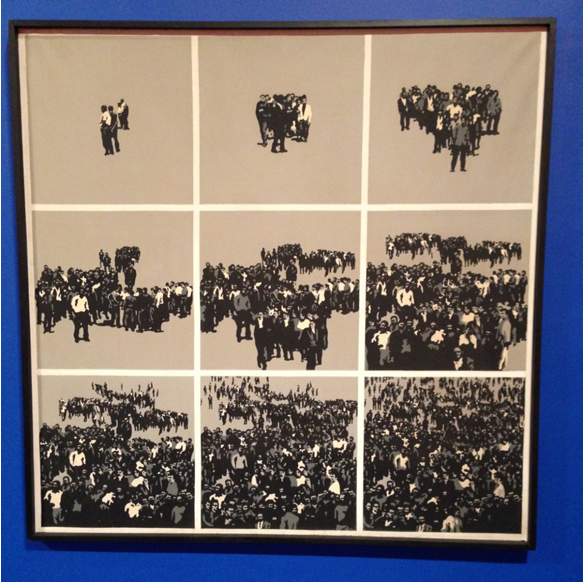'The World Goes Pop' exhibition opens at Tate Modern
- By Tom Cunliffe
 0 Comment(s)
0 Comment(s) Print
Print E-mail China.org.cn, September 16, 2015
E-mail China.org.cn, September 16, 2015
|
|
|
Concentration or Quantity becomes Quality - Equipo Cronica, 1966. [Photo/China.org.cn] |
The press viewing of the new exhibition at the Tate Modern called The World Goes Pop took place on September 14, 2015. The exhibition curators introduced it, and explained that what makes it unique and groundbreaking is its international scope. Whilst pop art is traditionally seen as being an Anglo-American art movement, many artists around the globe were in fact engaged in creating varying forms of 'pop art' in the sixties and seventies. This exhibition aims to reveal these forgotten voices and their different approaches to pop art. They often subverted the Anglo-American focus on commercial culture and celebration of Western consumerism to address local and global issues of the time, in many cases becoming manifestations of political protest from around the world.
The curators explained that pop art could be considered as one of the first global movements in art, although many of the international artists featured in the exhibition were unaware of famous pop art practitioners such as Andy Warhol. Even a French artist might not have been aware of what a German contemporary was working on, and so there was a lack of dialogue between different artists in this movement. They were simply creating local iterations of pop art in response to contemporary events. This exhibition also excavates relatively unknown artists, many of whom have been largely forgotten about in art histories and are in some cases unknown in their own countries. Many of the displayed works were never talked about at the time of their original release, and so are only now entering the limelight.
Pop art is traditionally connected with the individual consumer or single celebrity figure. Global pop artists however often drew on the crowd as a way to represent contemporary culture. For instance, the Spanish collective Equipo Cronica's "Concentration or Quantity becomes Quality" from 1966 presents a series of pictures of a gradually increasing crowd of people, celebrating the possibility of individuals joining forces to become an effective collective resistance to Francisco Franco's regime.
|
|
|
Sketch 1, 2, 3, 4 for the U.S. Flag - Raimo Reinikainen, 1966. [Photo/China.org.cn] |
Finish artist Raimo Reinikainen's series of "Sketches for the U.S. Flag" from 1966 embody a similar political protest sentiment. All four of the works replace the American Flag's red and white stripes with rainbow colours, and its stars with newspaper photographs of the Vietnam War. They aimed at condemning the United States' role in the conflict. Many artists in other artworks from around the world on display use the seductive visual language of advertising juxtaposed with scenes of violence to critique various political problems.
|
|
|
Happy Reunion - Isabel Oliver, 1970-1973. [Photo/China.org.cn] |
Another difference in the global focus on pop art is the amount of female artists included, challenging the assumption that pop art was dominated by men. The blonde bombshells, epitomised by Marilyn Monroe, and advertising models are famous images of Anglo-American pop art, but many of the female artists in this exhibition present more complex portraits of the female body and the women's emancipation movement. Spanish artist Isabel Oliver's paintings deal with what it meant to be a woman in Spanish society during the early 1970s. "Beauty Products" and "Surgery" investigate the conflicting expectations expected of a woman's appearance whilst "Happy Reunion" seemingly celebrates domestic success, but upon further consideration suggests the constrictions that society places on women.
Various other artists work on display blended their own local folk traditions with a pop art aesthetic to create something both local and contemporary.
Overall, this exhibition is a fascinating glimpse at a global art movement comprising many different cultures that has traditionally been seen as being dominated by Anglo-American male artists. Pop art's global manifestations dealt with both local and global political tensions and ways of life, which were often very much ahead of their time. This explains there relative absence up to now on the international art stage and their still very fresh perspective.
A number of related events including a forum on pop art with talks from various artists and a film programme will also accompany the exhibition. Information is available at: http://www.tate.org.uk/whats-on/tate-modern/exhibition/ey-exhibition-world-goes-pop
The World Goes Pop Exhibition is part of the EY exhibition series, a series of major exhibitions that started in 2013 at Tate Modern and Tate Britain. Next year's EY exhibition, opening on September 14, 2016, will be a major retrospective of Cuban-Chinese artist Wifredo Lam.









Go to Forum >>0 Comment(s)